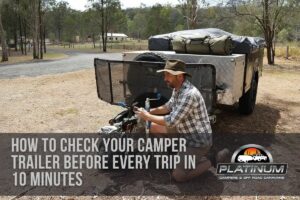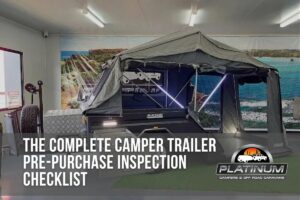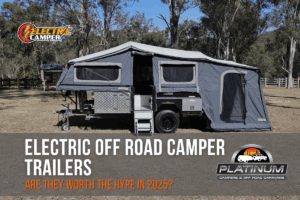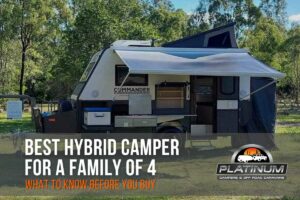Australian roads are tough on camper trailers, with long distances, changing weather and rough outback tracks putting constant stress on couplings, tyres and running gear. A quick, consistent 10‑minute check before every trip helps avoid breakdowns, improves safety and protects the investment families make in a quality off‑road camper.
Platinum Campers are engineered specifically for Australian touring, with strong chassis, off‑road suspension and practical layouts designed for families and adventurers who want to tow with confidence. A simple routine check makes it easier for those strengths to shine on every journey, whether heading for a weekend at the coast or a long‑haul outback trip.
This guide explains how to check a camper trailer in just 10 minutes using a structured, front‑to‑back system that anyone can follow. It is tailored for owners of off‑road campers, including the Platinum Campers range, and suits both first‑time buyers and experienced travellers looking for a reliable pre‑trip ritual.
Key takeaways
- A repeatable 10‑minute pre‑trip check dramatically reduces the risk of roadside issues and unsafe towing.
- Focus first on the most critical safety points: coupling, safety chains, tyres, brakes and lights.
- Walking around the trailer in a set order helps ensure nothing is forgotten in the rush to leave.
- Platinum Campers’ off‑road design makes checks straightforward while supporting long‑term reliability.
- Combining this quick routine with scheduled servicing delivers the best protection for families and gear.
Why a 10‑Minute Check Matters in Australia
Australian touring often means long stretches between towns, rough corrugations and changing conditions that can expose any weakness in a camper trailer setup. A simple fault such as a loose wheel nut or an under‑inflated tyre can quickly become a major failure when towing at highway speeds or along a rocky track.
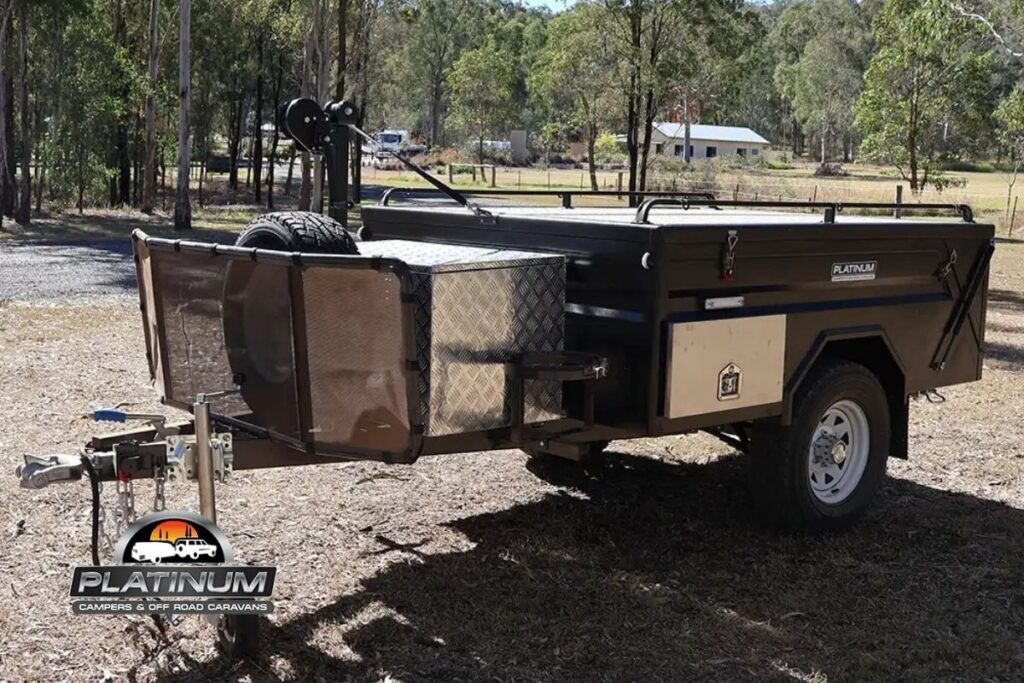
A short pre‑trip inspection before each journey is not intended to replace professional servicing, but it is highly effective at catching visible problems that appear between service intervals. This is particularly important after travelling on corrugated roads, tackling beach access tracks or returning from a long period of storage.
Platinum Campers designs its off‑road camper trailers with Australian conditions in mind, using robust construction, off‑road suspension and quality running gear to handle demanding environments. Owners who adopt a quick pre‑trip routine get more from these design advantages and experience fewer unpleasant surprises on the road.
For longer‑term care beyond the 10‑minute routine, Platinum’s maintenance tips for your camper trailer give additional guidance on servicing intervals and component care.
The 10‑Minute Pre‑Trip System: Front to Back
The easiest way to complete a full check in 10 minutes is to follow a consistent pattern every time. Starting at the towbar, work methodically to the rear of the trailer, then loop back along the other side, checking from the top down at each stop.
This system can be broken into five clear stages: tow coupling, safety equipment, wheels and tyres, lights and electrics, and load security. By spending one to two minutes on each area, owners can assess the most important safety factors without needing tools or specialist knowledge.
Platinum owners and buyers researching their first camper can also review the camper trailers range to see how different models arrange drawbars, storage and running gear, which makes it easier to create a personal checklist for a specific layout.
Step 1: Check the Tow Vehicle and Coupling (About 2 Minutes)
The connection between tow vehicle and camper is the single most important safety point in the entire combination. If the coupling is not correctly seated or locked, there is a real risk of trailer separation or unstable towing, especially on rough or uneven roads.
Start at the towbar and confirm the towball or off‑road coupling is fully seated with no visible gaps. The latch or handle should be in the locked position, and the safety pin or clip installed through the designated hole so that vibration cannot cause it to release.
Next, look at the tow tongue and hitch pin to make sure both are correctly installed and secured with a suitable R‑clip or locking device. A quick attempt to lift the front of the drawbar by hand is a practical way to double‑check that the coupling is properly engaged and not just appearing correct from a distance.
Platinum’s focus on off‑road ready drawbars and couplings is evident across the Platinum camper trailers lineup, making it easier for owners to use quality hardware that stands up to the demands of Australian travel.
Step 2: Safety Chains, Jockey Wheel and Handbrake (About 2 Minutes)
Once the coupling has been confirmed, move directly to the rest of the front‑end safety equipment. Correctly fitted safety chains and properly stowed jockey wheels are essential to safe towing and are legally required on public roads.

Check that the safety chains are attached to the towbar using rated shackles, ideally crossed under the drawbar where appropriate so they can support it if the coupling fails. The chains should have enough slack for turning but must not be so long that they can drag on the road or catch on obstacles.
Verify that rated D‑shackles are tight and in good condition, without distortion or heavy corrosion. At the same time, inspect the trailer handbrake to ensure it is fully released before departure, because any partial application can overheat brake components within a short distance.
Finally, confirm that the jockey wheel is fully raised, locked into its travel position or removed depending on design, and that the clamp is tight so that the wheel cannot rotate down while on the move. This simple step prevents roadside incidents caused by a jockey wheel striking the ground during towing.
Platinum’s strong A‑frame and front‑end layout, used throughout the off‑road camper trailers range, helps owners position all of this equipment correctly and safely.
Step 3: Wheels, Tyres and Suspension Glance (About 2–3 Minutes)
Tyres and running gear are among the most common causes of roadside difficulties for caravans and camper trailers. Under‑inflated tyres, uneven wear, loose wheel nuts and bearing issues can all lead to serious trouble if they go unnoticed before a drive.
Walk around the camper and look closely at each tyre, inspecting for visible damage such as cuts, bulges or objects lodged in the tread. Even without a gauge, a firm push or kick on each tyre can offer a basic feel for whether it is properly inflated, but using a pressure gauge whenever time permits is strongly recommended.
Next, scan each wheel for missing or potentially loose nuts, paying attention to any signs of fresh rust streaks or metallic dust around studs. Where any doubt exists, a wheel brace can confirm that nuts are secure, and owners should be particularly careful after any recent wheel changes or tyre rotations.
Take a brief look at each hub area for leaks or signs of excessive heat from previous travel, such as discolouration or a burnt smell. From a kneeling position on either side, glance at suspension hangers, shackles and shock absorbers to ensure no bolts are missing and that no brake lines or wiring are hanging low or rubbing against moving parts.
For a deeper dive into long‑term care of bearings, hubs and suspension, Platinum’s camper maintenance tips are a useful companion to this quick check.
Step 4: Lights, Electrics and Plugs (About 2 Minutes)
Working lights and a secure electrical connection are essential for safe towing and are required by road regulations. Without functioning brake lights, indicators and tail lights, other road users may not see the camper clearly or predict its movements.

Begin at the drawbar and check that the trailer plug is fully inserted into the tow vehicle socket, with any locking tab engaged properly. Gently move the plug to confirm it will not fall out when exposed to vibration, and follow the cable with your eyes to ensure it is not pinched in the coupling, kinked or hanging too low.
Where two people are available, one person can sit in the tow vehicle while the other stands behind the camper to confirm indicators, brake lights, tail lights and number plate lights are all working. Solo travellers can still check indicators and tail lights by using hazard lights and mirrors, and brake lights by reversing towards a reflective surface at night when practical.
Platinum Campers uses modern LED lighting and durable wiring looms on its off‑road designs, which offers better resistance to vibration and moisture than older systems. Owners wanting more detail on the electrical and off‑grid options available can review the off‑grid setups outlined on each model page.
Step 5: Doors, Latches, Load and Interior (About 2–3 Minutes)
The last stage of the 10‑minute check focuses on securing storage, equipment and internal items so that nothing opens or shifts dangerously during travel. This also helps protect cabinetry, appliances and accessories from damage caused by movement.
Walk around the exterior of the camper, pulling gently on each door, hatch and storage lid to confirm that every latch is properly closed and, where appropriate, locked. Pay particular attention to kitchen slides, fridge compartments and front toolboxes, which can sometimes appear closed but may not have fully engaged latches.
Check that stabiliser legs are all raised and fully stowed, with any pins or clips in place. At the same time, confirm that awnings, steps and loose accessories such as poles have been packed away correctly so nothing drags on the road or catches wind at speed.
Where the camper has front storage for gas bottles, jerry cans or heavy gear, make sure each item is firmly strapped or clamped and that gas taps are turned off at the bottle. Inside the camper, look for loose items that may move forward under braking and verify that all cupboards, drawers and fridge doors are latched for transit.
Travellers planning to finance a new off‑road camper can use Platinum’s camper finance page to explore options and understand how a well‑maintained trailer helps preserve value over the life of the loan.
Going Beyond 10 Minutes for Longer Trips
The 10‑minute routine is ideal for day‑to‑day departures, but longer or more demanding journeys justify a slightly deeper pre‑trip session. This is especially important when heading into remote areas, doing extensive off‑road driving or towing at higher loads than usual.
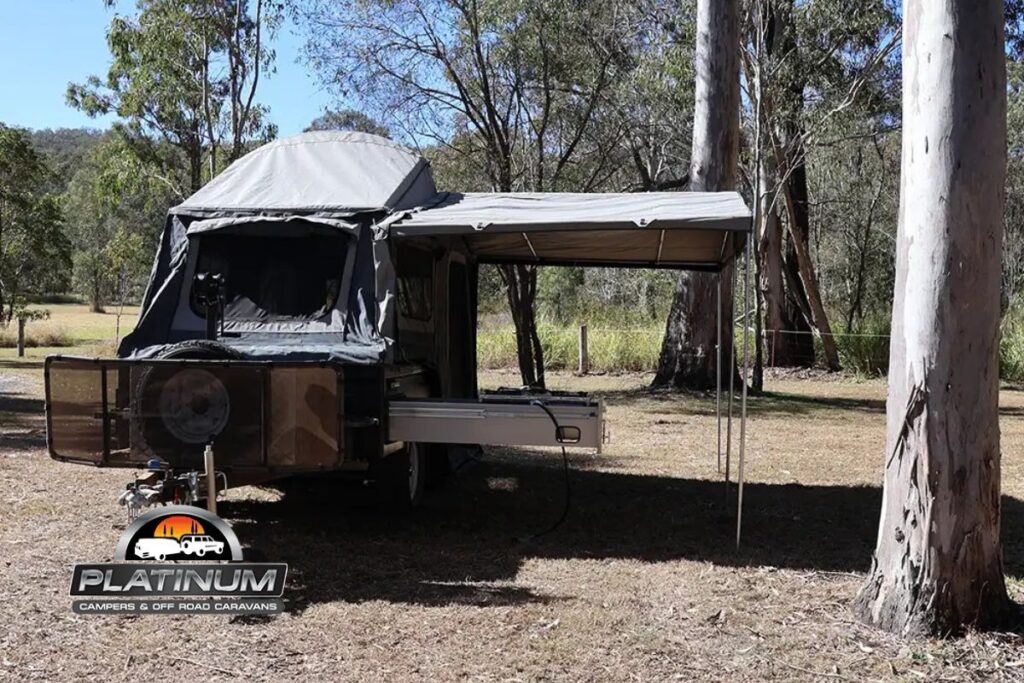
When time allows, add a proper tyre pressure check with a gauge, ensuring both the tow vehicle and camper tyres are at suitable pressures for the planned conditions. A torque wrench can be used to confirm wheel nuts are tightened to the manufacturer’s specification, which is particularly recommended after new tyres or wheel work.
Drivers can also inspect fluid levels in the tow vehicle, including engine oil, coolant and windscreen washer fluid, and perform a closer look at brake components where safely visible near the backing plates. Finally, confirming the presence of key tools and spares – such as an inflated spare wheel, jack, wheel brace and coupling‑specific tools – is a simple way to improve preparedness.
For broader routine care, Platinum’s maintenance tips for your camper trailer outline sensible intervals and checks that complement the pre‑trip routine explained in this article.
10‑Minute Pre‑Trip Camper Checklist (Copy and Use)
The simplified checklist below can be printed and kept in the glovebox or stored on a phone for quick reference. It reflects the same front‑to‑back workflow already covered in more detail.
1. Coupling and Towbar
- Coupling fully seated on towball or off‑road head
- Latch locked with safety pin or clip in place
- Tow tongue and hitch pin installed, with R‑clip or lock fitted
2. Chains, Handbrake and Jockey
- Safety chains attached to towbar with rated shackles
- Chains crossed under drawbar where suitable and not dragging
- Trailer handbrake completely released before driving off
- Jockey wheel fully raised and locked, or removed for travel
3. Wheels, Tyres and Suspension
- Tyres show no visible cuts, bulges or lodged objects
- Tread appears even and adequate across each tyre
- Tyres feel firm to a push or have been checked with a gauge
- All wheel nuts present, with no signs of movement at studs
- Hubs show no fresh grease leaks or obvious heat damage
- Quick glance underneath at hangers, shocks and wiring for loose parts
4. Lights and Electrical Connection
- Trailer plug fully inserted and secure in vehicle socket
- Cable not pinched in coupling or dragging on the road
- Indicators, brake lights and tail lights working correctly
- Number plate light operating for safe night driving
5. Doors, Latches and Load
- All hatches, doors and storage lids fully latched
- Kitchen, fridge and tool slides locked in their travel positions
- Stabiliser legs fully stowed and pinned
- Awnings, steps and poles packed away and secure
- Gas bottles turned off and properly strapped
- Heavy items strapped down, cupboards and fridge latched inside
Frequently Asked Questions
How often should this 10‑minute check be done?
The 10‑minute inspection should be completed every time the camper moves, whether it is a weekend away, a long‑distance holiday or a short tow to storage. Many travellers also repeat a quick version at major fuel stops to confirm tyres, couplings and lights are still performing as expected.
Is a 10‑minute check enough before remote trips?
Before remote or heavily off‑road journeys, the 10‑minute routine should be combined with a recent professional service that includes bearings, brakes, suspension and full electrical checks. The quick check then acts as a final confirmation that everything appears sound just before setting off.
Do brand‑new campers still need pre‑trip checks?
Yes, even brand‑new trailers benefit from a simple walk‑around before every drive, because towing loads, storage conditions and minor adjustments can all influence how components behave. Early use of a checklist also helps new owners learn where everything is located on their specific model.
What basic tools should be carried with this checklist?
While the 10‑minute routine can be performed largely without tools, many owners keep a tyre gauge, wheel brace, torque wrench and head torch in the tow vehicle. These items make it easier to confirm wheel nut torque and tyre pressure quickly when time or conditions allow.
How do owners know the correct tyre pressures to use?
Recommended cold tyre pressures are generally listed on the trailer’s compliance plate or in the owner’s manual, and may be adjusted slightly for different loads and surfaces. Some travellers keep a small note of their preferred highway, gravel and sand pressures in the glovebox for quick reference.
Should the handbrake be on or off when towing?
The trailer handbrake must be fully off whenever the camper is being towed, because driving with it partially engaged can quickly overheat brakes and damage running gear. It should only be applied when the camper is parked, usually with wheel chocks for additional security.
How often should wheel bearings and brakes be serviced?
Service intervals vary with usage and conditions, but many Australian owners organise at least an annual inspection or book in sooner if they travel frequently off‑road. Any signs of heat, noise, vibration or leaking grease from the hub area warrant an earlier check by a qualified workshop.
What should be checked inside the camper before travel?
Inside the camper, focus on anything that can open or move: ensure cupboards and drawers are latched, fridge doors are locked and loose items such as appliances or cooking gear are secured. This reduces noise while driving and protects joinery and fittings from impact damage.
Does this checklist only apply to Platinum Campers?
The same general principles apply to most camper trailers, but Platinum Campers designs are tailored to Australian off‑road use, which can influence how components are arranged and secured. Owners can combine this checklist with their model‑specific documentation and Platinum’s maintenance tips for the best results.
Ready to Tow with Confidence?
A fast, consistent 10‑minute pre‑trip check is one of the simplest ways to make every journey safer and less stressful, especially when towing with family or heading off the beaten track. When combined with quality equipment and regular servicing, this routine helps avoid many common roadside problems.
Travellers who are still choosing their ideal setup can explore the camper trailers range to find an off‑road camper designed for Australian conditions and practical, real‑world touring.



